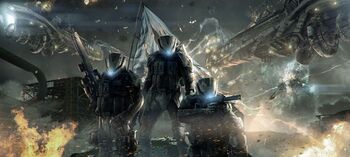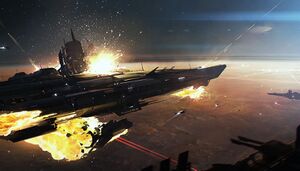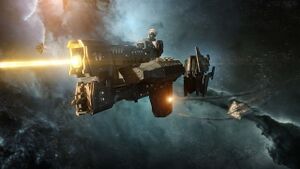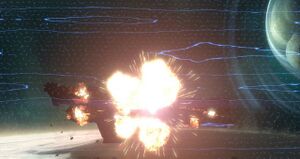Battle of Nuvari
| Battle of Nuvari | |||||||
|---|---|---|---|---|---|---|---|
| Part of the Milky Way Conflict | |||||||
 Concordian marines recapture the Nuvari Shipyards. | |||||||
| |||||||
| Combatants | |||||||
| File:Flag of the Concordian Federation.png Terran Concordium | File:Confederation of Planets.png Oderran Confederation | ||||||
| Commanders and leaders | |||||||
|
File:Flag of the Concordian Federation.png Fleet Admiral D'vit Mimuda General Charles Tomasky | File:Confederation of Planets.png Field Admiral Jackson Rufus | ||||||
| Units involved | |||||||
|
Naval units Perseus Fleet
Ground units
|
Naval units 5th Confederate Fleet
Ground Units
| ||||||
| Strength | |||||||
|
File:Flag of the Concordian Federation.png Concordian
6,257 starships
5.21 million total vehicles
|
File:Confederation of Planets.png Confederate
11,902 starships
15 million vehicles
| ||||||
| Casualties and losses | |||||||
|
3.9 million injured or killed
Material |
9.7 million injured or killed
Material | ||||||
| Estimates of civilian casualties are between 920,000 and 2.01 million | |||||||
The Battle of Nuvari was a significant battle fought in the space around and on the planet of Nuvari between the Terran Confederation and the Oderran Confederation during the Great Intergalactic War between December 1st, 3251 and May 22nd, 3252. It was one of the bloodiest battles of the entire war and saw the defeat of a significantly numerically superior Oderran force at the hands of the Terran Concordium. The Concordian victory in the battle marked the end of the First Counteroffensive by the Confederation.
The initial strategy of the Confederates was too overwhelm the Concordian forces that had recently entered Confederate territory and occupied several planetary systems, with Jarvis system being the furthest point into Confederate territory Concordian forces had taken since November. The Confederates sent two fleets to lead the counter offensive which would later be known as the First Counteroffensive, and these two fleets were the tip of the spear for a series of Confederate counterattacks against the Concordians. While the Confederates massively outnumbered the Concordians, the more advanced technology and tactical prowess of the Concordian commanders resulted in heavy casualties for the Confederacy in both space and on the ground. Eventually the casualties had amounted to too much for the Confederates and the counteroffensive was declared fruitless. They withdrew and was left with a large portion of their fleets destroyed and massive amounts of manpower lost in a demonstration of superior technology and tactics triumphing over sheer numbers.
Preparation for Counteroffensive
To prevent the Confederation from simply warping past the Jarvis system, several massive interdiction field generators were placed at Nuvari. These had a range of over one thousand light years and effectively funnelled the Confederate Navy into a chokepoint they had to get through to proceed with their counteroffensive. To accomplish this, the mastermind of the Confederate First Counteroffensive and Battle of Nuvari, Field Admiral Jackson Ruthus, believed firmly in the usage of a large overwhelming force against the technologically superior Concordian forces. He asserted that the only way for the Confederation to have any hope of successfully repelling the advancing Federation was to counter them with a large force in a surprise attack that would catch the Concordian forces off-guard and result in their destruction before significant resistance could be initiated. To accomplish this, he discussed with the Confederate Supreme Command and laid out a demand for at least 2 major fleets to successfully repel the invaders, but several of these fleets had been almost completely destroyed in the initial combat against the Federation. To remedy this, the comparatively small 5th and 6th Confederate fleets were up-numbered with thousands more ships of all types and hurriedly prepared for combat.
Originally the plan was to intercept the Concordian fleet at Nuvari, but the rapid push of Concordian forces into Confederate territory on November 23rd resulted in a quick shift in plans. The new plan was to directly assault Nuvari and take back the Confederate systems in a wave-like formation, sweeping across the planetary systems like a broom. Thus the so called "Operation Broomhandle" was ready to be executed on December 1st.
Concordian Defence Preparations
The Confederation's plan did not go unnoticed however, as the Office of Concordian Intelligence was able to gain intelligence that the Confederation was preparing for a major fleet engagements. The build up of the fleets had also been detected by stealth reconnaissance probes that had been inserted earlier into Confederate territories. This was sufficient proof to Concordian HIGHCOM to prepare for a suspected counterattack by the Confederation. On November 28, Fleet Admiral D'vit Mimuda, commander of the Perseus Fleet, was ordered to defend the recently acquired territories at all cost. A later memoir written by him detailed this order:
HIGHCOM wrote the order very simply: "Defend the systems recently acquired at all cost."
— Memoir of a Fleet Admiral (D'vit Mimuda)
The Perseus Fleet had been depleted of its strength from all the heavy fighting with multiple Confederate fleets so Mimuda was forced to use unconventional tactics and improvise. He ordered that asteroids be placed around the orbit of Nuvari, concealing hidden antimatter mines while hundreds of orbital defence cannons were placed around the planet. He selected half of his fleet to be placed on the other side of the planet, being concealed from Confederate sensors while the other half was concentrated into a tight triangle formation. Space debris from the previous space battle that was fought for the capture of this planet had boosters and guidance systems attached, turning them into makeshift shrapnel projectiles. In case of attempts to land on the planet, General Charles Tomasky was tasked with fortifying strategic locations such as the capital, ship yards, space ports and industrial centres, placing several divisions of ground forces in "hotspots" or independent circular areas of defence in these locations. Each hotspot's garrison would only defend that area, preventing overstretched supply lines or front lines. It also had the added benefit of being able to quickly encircle an enemy. With only three days to prepare however, the defences were not fully completed when the Confederates began their attack.
At 09:20 on the 1st of December, specifically hidden probes located in asteroids detected several quantum disruptions indicative of warpspace exits. Immediately the Concordian defenders were put on high alert. However Mimuda was cautious: a very small number of warpspace exits had been detected and Mimuda correctly inferred this could not possibly be their main force. The Confederate Navy intended this small force as only scouts and consisted of several destroyers and frigates. It was at 9:27, when the scouting force entered the asteroid field, when an antimatter mine detonated automatically upon proximity, immediately vaporising three of the vessels, crippling two more and damaging the remaining two. Concordian defences remained silent; Mimuda knew the bigger force was yet to come.
Start of Assault
Two minutes later, several hundred warpspace signatures began to fluctuate all over the sensor scopes of the Concordian warships. Hundreds of capital warships began to pour out in two distinct prongs, heading in a pincer movement against the defending warships. They began opening fire at ranges near 50,000 kilometers, and the Concordianians responded by detonating several antimatter mines against the left "pincer" of the assault, instantly destroying at least thirty to fourty warships and crippling several more. Concordian gunfire began to open up on the attackers and soon the assaulting Confederate warships entered a killing zone of non-stop fire from the three hundred or so Concordian warships manning the front lines. Several more lines of warships began to open fire against the incoming force as well and Confederate warships took heavy casualties for their armour or shields were no match against the more powerful, accurate and longer ranged guns of the Concordianians.
Confederate destroyers, frigates and cruisers led the charge, absorbing the brunt of the incoming fire, protecting their crucial battleships that packed enough firepower to actually deal serious damage against Concordian warships. Their pincer attack began to become hopeless as the Concordian defenders were far too strongly focused all-around and were repelling the attacks easily by Confederate warships. Jackson Ruthus gave the order to converge the two pincers into a single large wave of overwhelming firepower. He called upon a relief wave of nearly 500 starships, sending them to reinforce the frontal assault. Unfortunately for Ruthus, the pincer attack had failed because Concordianian flank defences were extremely well protected with several battlestations orbiting the planet. It was up to his forward attack to break through the Concordian lines as there was no conceivable way of getting ground troops on the planet.
Deeds of the IFS Stoneface
The IFS Stoneface was a Sirius-class light frigate that became separated from the main Concordian defensive lines as several Confederate ships closed in to knife-fighting ranges. Seeing no conceivable way of returning back, the light frigate's captain, Prime Lieutenant Joseph H Io, ordered those now famous words: All engines to full power, we're going in boys. The Stoneface headed straight into the fray of the battle, engines at maximum output. It began a suicidal run and fired every single weapon it had available to it. She first engaged the closest Confederate vessel, the cruiser Maximovus within 20 kilometers. Dodging several shots from her, the Stoneface managed to break the shields of the vessel with a nuclear missile, leading to it being split in half a few moments later by a glancing blow from an Concordian battleship.
The Stoneface then came under attack by two Confederate destroyers, the Speedy Destruction and Trailblazer, who opened fire with their few broadside guns against the Stoneface at a range of around 100 km. As Confederate broadside guns were not very powerful, especially on a destroyer, the few rounds that did manage to strike the shielding of the Stoneface did very little damage. The Stoneface responded by firing a barrage of anti-ship missiles towards the two vessels, though most were intercepted by their point defense systems. The few that did get through were able to do significant damage against the two destroyers, which had no shields. The Speedy Destruction was hit by at least five Ruiner anti-ship missiles, two of which confirmed to hit the reactor area of the vessel, causing a catastrophic explosion that tore the ship apart. The Trailblazer was hit by seven missiles, three of which impacted the main armor belt, causing significant damage to the mid decks of the ship and disabled forward gunnery control. The rest of the missies impacted against the rearward weapons compartments, causing a detonation of the stored missiles there, ripping the engines and reactors off the ship and crippled it for the rest of the battle.
By now the Stoneface had been surrounded by the rest of the attacking Confederates. The Stoneface was atacked by broadside fire from at least three Confederate cruisers, lowering shield integrity to around 35%. The ship proceeded to perform a series of heavy evasive maneuvers that caused several Confederate warships to miss their shots. The Stoneface fired several rounds from its main armament against the nearest Confederate to its front, the CRS Daring, dropping its shields and damaging its main battery guns. The Daring returned fire with several broadside cannons, along with several other Confederate warships. At this point, the Stoneface was now depleted of its shields and the hull armour took a severe beating from the incoming fire. Then, the Confederate battleship, Devious Intent, entered the fray; its nose pointed straight towards the Stoneface. A single shot from the battleship smashed straight through layers of metal and graphene and tore a massive 100 metre hole in the bow, disabling its spinal railgun and crippling the vessel's maneuverability. Ho, knowing the ship was doomed, ordered the crew to abandon ship, overload the reactor and fire every single weapon it had left against the battleship.
The ship was soon on a ramming course with the multikilometer vessel. Several nuclear missiles struck the Devious Intent, punching straight through the shields, then the Stoneface collided right into the bow, ripping through the armour and lodging itself into the main ammunition storage. Then the reactor of the Stoneface overloaded, instantly disintergrating the Stoneface and splitting the Devious Intent in half in a massive range of explosions. The final sacrifice of the Stoneface had severely disrupted Confederate ship formation and soon dozens of vessels were being picked off as debris from the Stoneface's suicidal run spewed everywhere, knocking ships off course and causing further collisions. The entire Confederate attack was in chaos. This made them easy pickings for the ready defenders who barraged them from long range with their antimatter cannons, resulting in heavy Confederate casualties.
Second Assault
Admiral Rufus had become desperate; his initial assault had been thrown in disarray and he was now at risk having his entire attack force, some 800 warships be destroyed at little cost to the Federation. He knew if this happened, the attack would be crippled and give time for the Concordian warships to reposition themselves and possibly receive reinforcements. Such an event would spell disaster for his secondary waves that were still getting ready to warp into the system. In need for a dire bail-out for his stricken attack force, Rufus warped in a battlegroup of 100 cruisers and destroyers directly above the Federation's lines, ready to exploit their unprotected upper flank. The attack was swift and decisive; the Concordian rear guard of battleships were caught completely off guard by this flanking manoeuvre and within mere seconds, the mobile Confederate cruisers had entered "knife-fighting" ranges against the battleships, forcing them to rely on broadside guns, limiting their damage output. Several battleships were destroyed in the midst of the chaos and a confusion set in on the Federation lines. As the Federation fought the flankers within their ranks, Rufus ordered his initial attack force to full speed and engage the dis-unified Federation warships at close range. Several Confederate warships even used ramming tactics to thwart the Federation warships.


